Microbiology Exam 2, Dr. Collins
1/139
There's no tags or description
Looks like no tags are added yet.
Name | Mastery | Learn | Test | Matching | Spaced | Call with Kai |
|---|
No study sessions yet.
140 Terms
Giardia lamblia
A microaerophilic protist with flagella. They do NOT have mitochondria, but instead have mitosomes (mitochondria-like double-membrane bounded organelles)
Which scientist first identified Giardia lamblia?
Antony van Leeuwenhoek
Why is the formation of cysts the key to survival for Giardia lamblia?
These cysts protect the disease against nutrient deficiency, desiccation, adverse pH, and low O2. The cysts are considered to be the infective stage of the disease because they are how Giardia is transmitted.
____________ is NOT an effective water treatment to get rid of Giardia lamblia
Chlorination
Giardia colonizes and reproduces in the _______ _________
Small intestines
What microbe is the most common cause of epidemic waterborne diarrheal disease in the US, with 30,000 cases yearly?
Giardia lamblia
Treatments for Giardia infection:
Metronidazole, quinacrine (mepacrine), tinidazole, nitazoxanide, and furazolidone
2 ways to remove Giardia from water and prevent infection?
Slow Sand water filtration.
Boiling drinking water for 1 minute.
What are the 2 reproductive strategies of eukaryotic microbes?
Sexual reproduction (haploid or diploid) and asexual reproduction
Reproductive strategies of Bacteria and Archaea:
Bacteria and Archaea are haploid only. They reproduce asexually via binary fission, budding, or filamentous. All must replicate and segregate the genome prior to division
Binary fission
Pinches the cell down the middle, splitting it into two genetically identical cells.
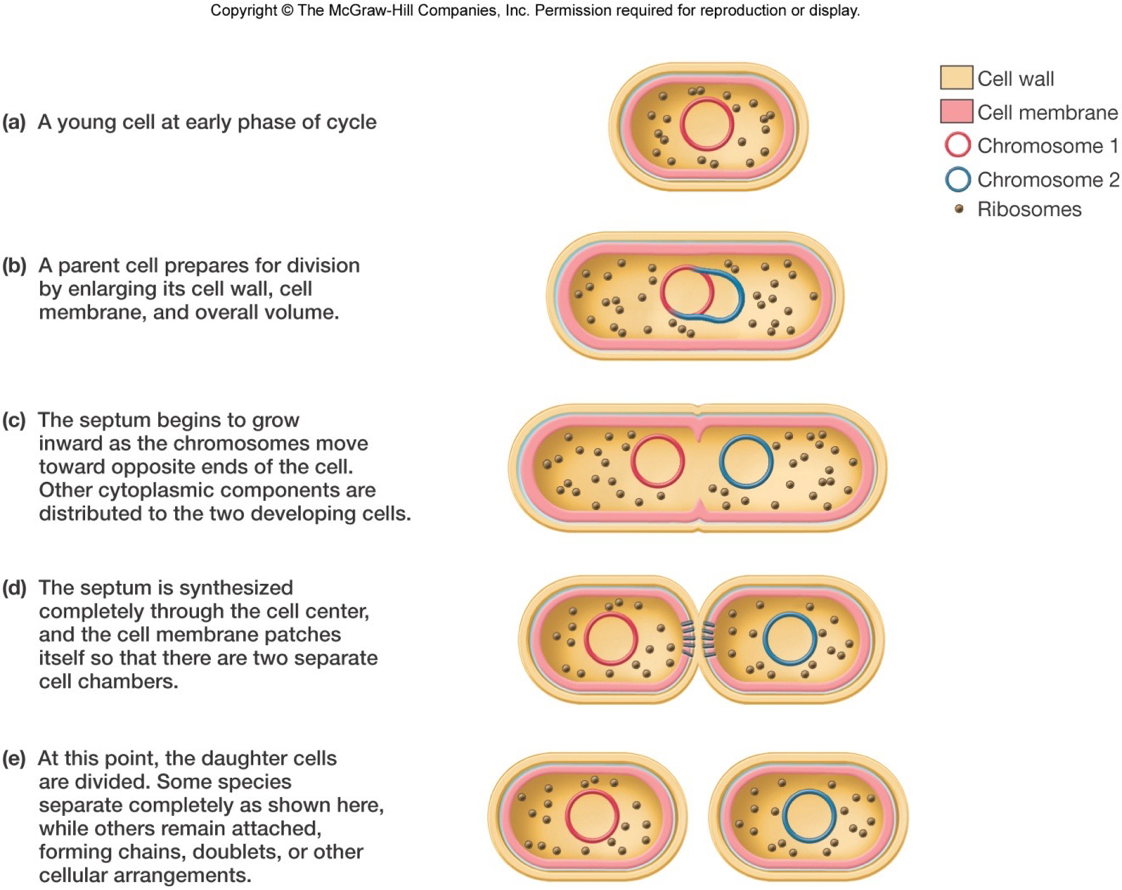
What is the cell cycle
It is a sequence of events from the formation of a new cell through the next cell division
What is the most common method of bacterial cell division?
Binary fission
What 2 pathways function during the cell cycle?
–DNA replication and partition
–Cytokinesis
Where does replication begin in bacterial cells?
It begins at a single origin of replication
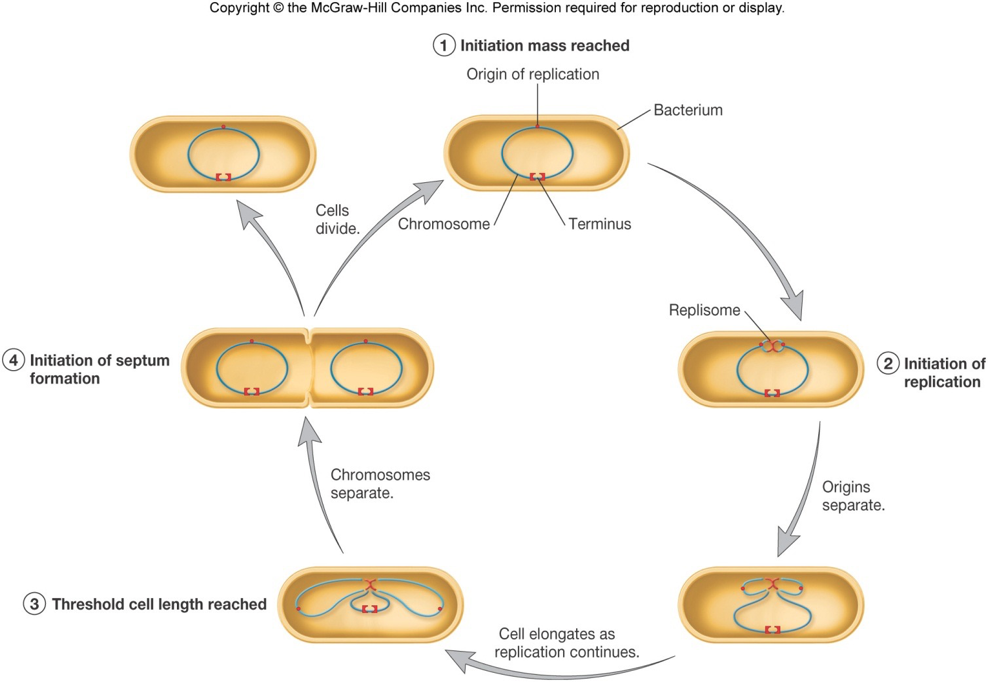
Ternimus
The site at which replication is terminated, located opposite of the origin.
Replisome
A group of proteins at the origin of replication. Needed for DNA synthesis.
Which direction does DNA replication proceed in?
DNA replication proceeds in both directions from the origin until it reaches the terminus.
What is MreB (murein cluster B)?
An actin homolog, which is involved in directing the chromosomes during chromosome segregation
What happens if MreB is mutated?
Chromosomes wont separate
Septation
The formation of cross walls between daughter cells
What are the steps of septation:
– Selection of site for septum formation
– Assembly of Z ring
– Linkage of Z ring to plasma membrane (cell wall)
– Assembly of cell wall synthesizing machinery
– Constriction of cell and septum formation
What is the Z ring made up of?
The protein FtsZ
How does the protein FtsZ create the Z ring?
FtsZ travels along the MinCDE tracks until it reaches the middle of the cell. The FtsZ protein then polymerizes in the middle of the cell, which forms a mesh of filaments. This creates the Z ring.
What limits the Z ring to the center of the cell?
the MinCDE tracks, which oscillate back and forth in the cell to prevent the Z ring from forming anywhere but the center.
FtsZ protein
A tubulin homologue found in most bacteria and archaea.
Cellular growth and cell shape are determined by ___________ _____________ in bacteria
Peptidoglycan synthesis
Where does peptidoglycan synthesis start?
In the cytoplasm
What is peptidoglycan made of?
Nag and Nam
Bactoprenol transports Nag and Nam that have been linked in the cytoplasm into the __________-
periplasm
Penicillin binding proteins (PBPs):
Crosslink peptidoglycan strands and catalyze controlled degradation for new growth. Penicillin binding proteins specifically targets cell wall synthesis. The cell has to be actively growing in order for the penicillin to work.
Autolysins:
PBP enzymes that degrade peptidoglycan to insert new peptidoglycan.
Characteristics of cocci cell division:
New peptidoglycan forms only at the central septum.
FtsZ determines site of cell wall growth.
FtsZ may also recruit PBPs for synthesis of septum.
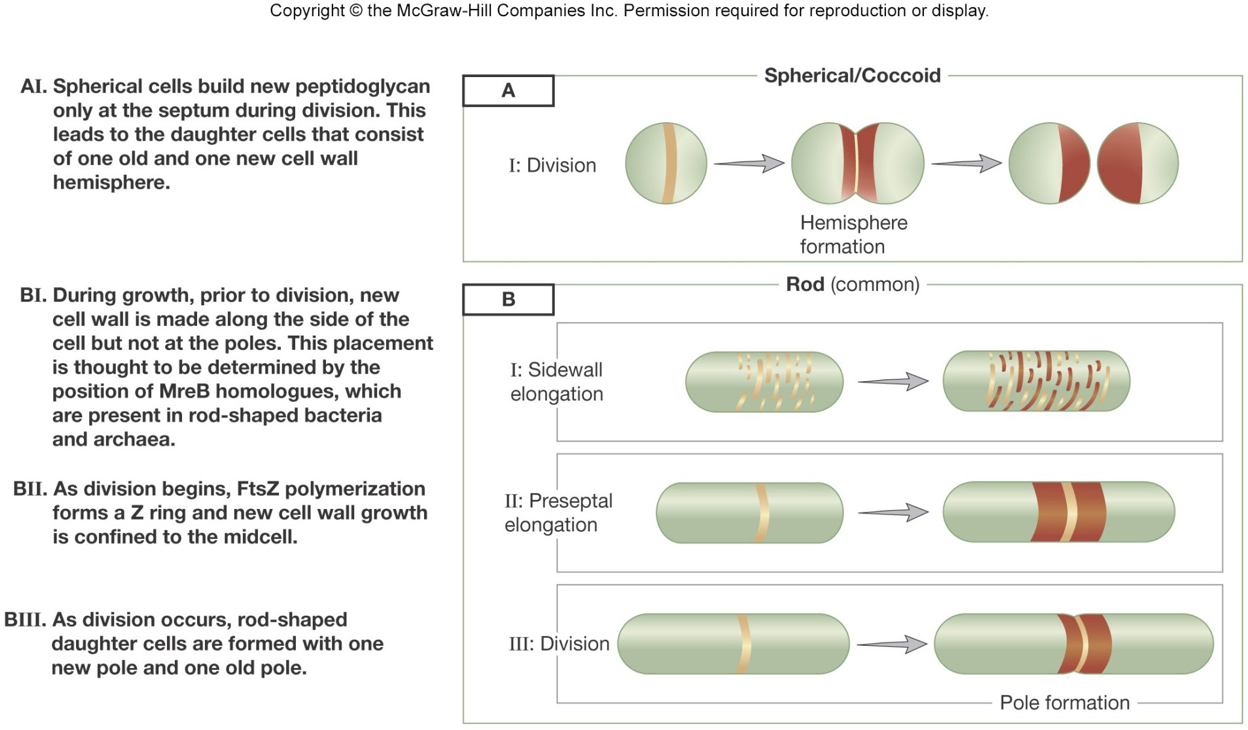
Characteristics of rod cell division:
Elongate prior to septation.
MreB determines cell diameter and elongation as Z ring forms in center.
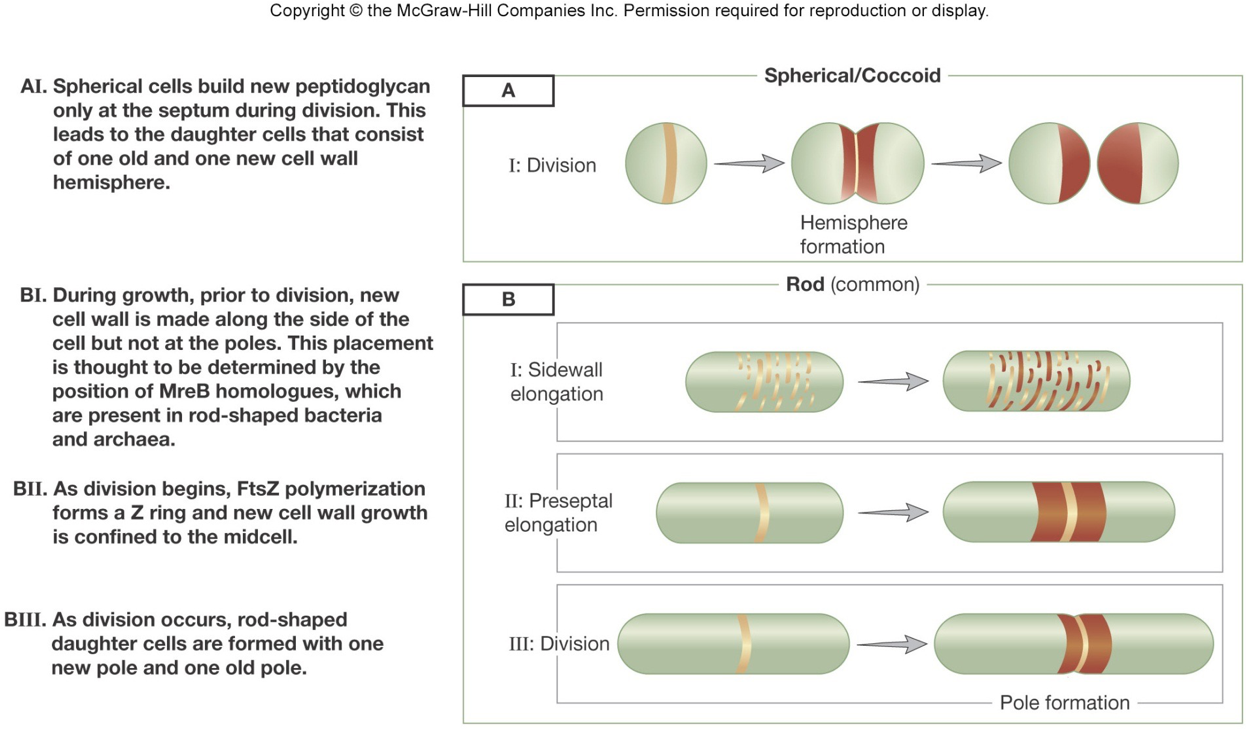
Cell growth is defined as:
An increase in cellular constituents that may result in:
–An increase in cell number
–An increase in cell size
Growth usually refers to __________ growth rather than growth of _________ cells
Population, individual
A Growth Curve is observed when microorganisms are cultivated in a ______ ________
Batch culture
Batch culture:
A culture incubated in a closed vessel with a single batch of medium
4 distinct phases of a growth curve:
Lag, Log, stationary, and death phase.
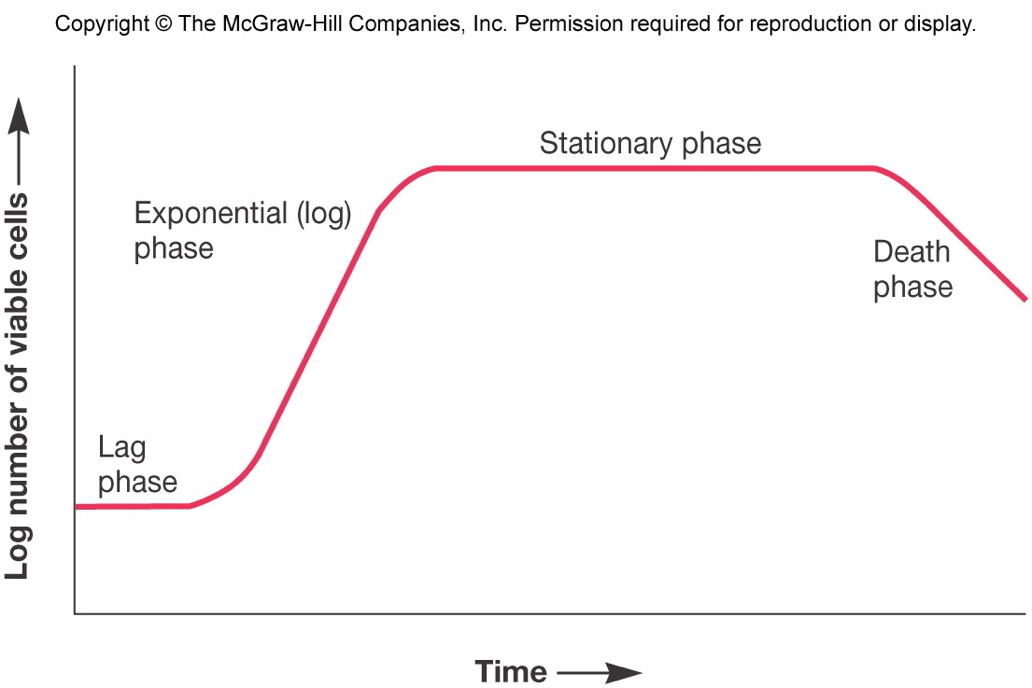
What happens during the Lag phase?
The cell is synthesizing new components to replenish spent materials and prepare for growth.
In some cases, Lag phase can be very short or even absent.
What happens during the Log phase?
Once the cell replenishes everything it needs, the Log phase begins.
The cell population experiences balanced growth during Log phase.
Population is most uniform in terms of chemical and physical properties during this phase.
Log phase determines generation time.
Generation time
The time it takes for the population to double.
What does balanced growth mean?
It is when cellular constituents are manufactured at constant rates relative to each other.
What does unbalanced growth mean?
When rates of synthesis of cell components vary relative to each other. This occurs under a variety of conditions such as a change in nutrient levels or a change in environmental conditions.
What happens during the Stationary phase?
Cell death rate = cell growth rate.
When closed system population growth eventually ceases, the total number of viable cells remains constant.
Active cells stop reproducing or reproductive rate is balanced by death rate.
Why do cells enter the stationary phase?
Cells enter into the stationary phase due to stressful conditions such as starvation, lack of oxygen, accumulation of waste, or population density being reached. This activates the survival strategy known as the starvation response.
Things cells do to prevent their death:
They go through morphological changes, such as forming endospores.
Some can’t form endospores, so they decrease in size, shrink their protoplast, and condense their nucleoid.
RpoS protein assists RNA polymerase in transcribing genes for starvation proteins.
The starvation response activates the production of starvation proteins, which:
Increase the amount of cross-linking in cell wall, making it stronger. Dps proteins protect DNA, and chaperone proteins prevent protein damage.
Persister cells:
Persister cells are dormant, non-dividing cells that are resistant to antimicrobials. This increases the virulence of a cell and benefits its long-term survival.
What happens during the death phase?
The activation of suicide genes happen in this phase. The cells are viable but not culturable.
What are two alternative hypotheses about the death phase and their explanations?
– That the cells are Viable But Not Culturable (VBNC): The cells are alive, but dormant, capable of new growth when conditions are right.
– That it is programmed cell death: A fraction of the population genetically programmed to die (commit suicide).
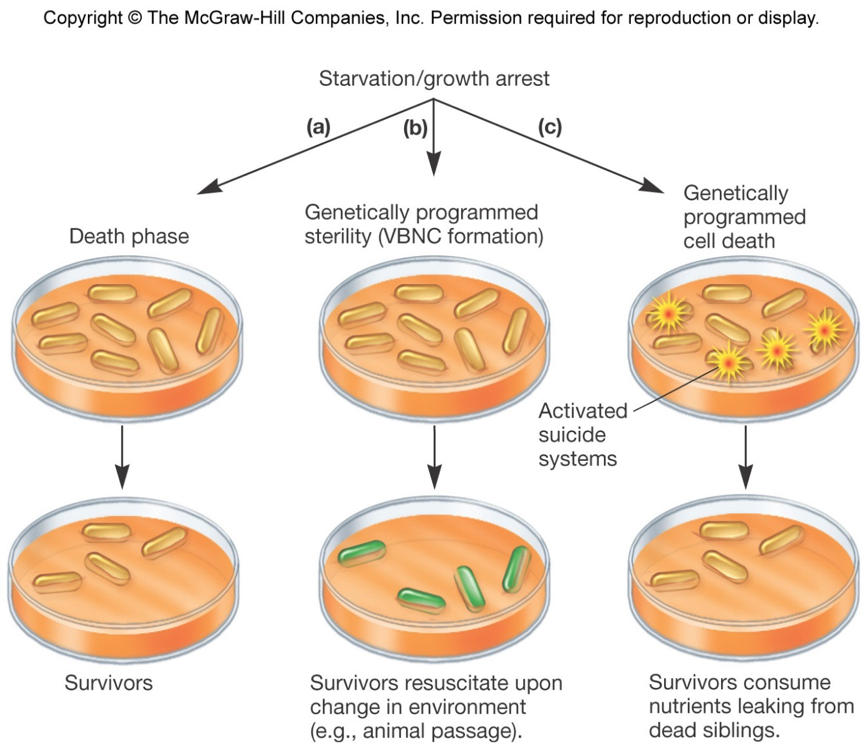
What is the generation (doubling) time:
– The time required for the population to double in size.
– Varies depending on species of microorganism and environmental conditions.
– Time range is from 10 minutes for some bacteria to several days for some eukaryotic microorganisms.
What can growth measure?
It can measure changes in number of cells in a population and changes in mass of population.
Methods of direct cell counts:
– Counting chambers
– Electronic counters – flow cytometry
– Membrane filters
Counting chambers
• A quick and easy way to visualize how many cells are there.
• Useful for counting both eukaryotes and prokaryotes.
• A disadvantage is that you cannot distinguish between living and dead cells.
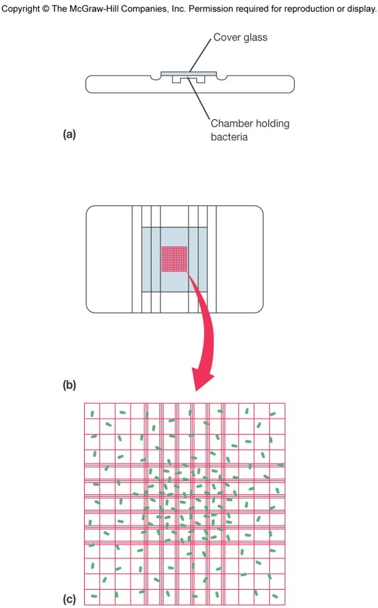
Membrane filters
• Cells are filtered through a special membrane that provides a dark background for observing cells.
• Cells are stained with fluorescent dyes so they can easily be seen on the filter.
• Useful for when you have a large amount of water and want to count how many cells are there.
• When used with certain dyes, we can distinguish living from dead cells.

Flow cytometry
• A microbial suspension is forced through a small channel with a laser light beam shining through it.
• The movement of microbes through the orifice impacts the electric current that flows through the orifice from the laser.
• Each time the current is disrupted, a cell is counted.
• Specific antibodies can be used to determine size and internal complexity of the cells.
Examples of viable plate count methods:
Spread and pour plate techniques.
Membrane filter technique.
Ways to measure cell mass:
Dry weight (time-consuming).
Measure the quantity of a particular cell constituent (DNA, proteins, ATP, chlorophyll, etc). Useful if amount of substance in each cell is constant.
Turbidometric measures: light scattering. (quick, easy, and sensitive).
What is a continuous culture of organisms?
It is growth in an open system that allows cells to remain in the log phase at a constant biomass concentration for extended periods of time.
There are constant nutrients and a continuous removal of waste.
Important uses for continuous culture methods:
Provides a constant supply of cells in log phase growing at a known rate.
Study of microbial growth at very low nutrient concentrations, close to those present in the natural environment
Study of interactions of microbes under conditions resembling those in aquatic environments
Used in food and industrial microbiology, which makes things like alcohol, antibiotics, and drugs.
The chemostat
The Chemostat is an open system where you provide more nutrients and take out the waste.
The rate of incoming medium = rate of removal of medium from vessel
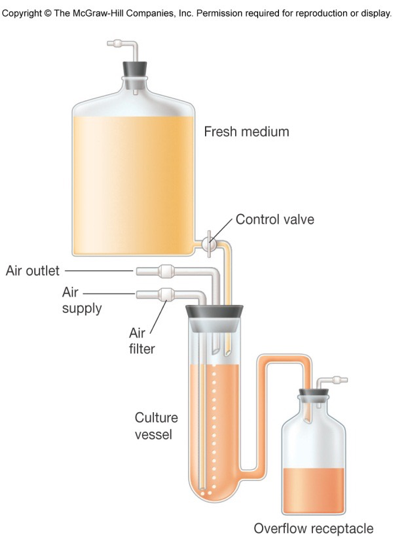
Extremophiles
Grow under harsh conditions that would kill most other organisms
How do cells reduce their internal osmotic concentration of cytoplasm in hypotonic solutions?
They use mechanosensitive (MS) channels in plasma membrane allow solutes to leave
How do cells increase their internal osmotic concentration in hypertonic solutions?
They increase their internal solute concentration with solutes compatible with metabolism and growth
Halophiles
Bacteria that THRIVE in high salt concentrations at a concentration above about 0.2M
Extreme halophiles
– Require salt concentrations of 2M and 6.2M
– Extremely high concentrations of potassium
– Cell wall, proteins, and plasma membrane require high salt to maintain stability and activity
More hydrogen ions = higher ________ = more ________
pH, acidic
Acidophiles
Grow optimally between pH 0 and pH 5.5
Neutrophiles
Grow optimally between pH 5.5 and pH 7
Alkaliphiles (alkalophiles)
Grow optimally between pH 8.5 and pH 11.5
What is the acidic tolerance response?
The plasma membrane is impermeable to protons, so it exchanges H+ ions for K+. Pumps in the Plasma Membrane pump H+ ions out of the cell to maintain a neutral internal pH.
Many microorganisms can change the pH of their habitat by producing _________ or __________ waste products
Acidic, basic
Acid tolerant proteins
Maintain the 3 dimensional structure of proteins
Can microbes regulate their own internal temperature, Y/N?
No
Psychrophiles
Microorganisms growing at temperatures ranging from 0-15 degrees C
Psychrotrophs (Psychrotolerant)
Microorganisms that CAN grow in cold temperatures but grow optimally at temperatures between 25-45 degrees C
Mesophiles
Microorganisms ONLY growing at temperatures between 25-45 degrees C
Thermophiles
Microorganisms that grow at temperatures optimally above 55 degrees C
Hyperthermophiles
Grow between 85 to 113o C
Organisms that grow in the fridge are examples of ______________ microbes
Psychrotolerant
Characteristics of Psychrophiles:
They have unsaturated fatty acids.
They have antifreeze proteins such as glycerol and sugars that decrease the freezing point in cytosol.
Characteristics of thermophiles:
They have saturated fatty acids.
Have branched fatty acids.
Thermophiles have ether linkages.
They have histone-like proteins that protect DNA.
Their protein structure is stabilized by more H bonds, more proline, and chaperones (help protect the proteins).
The growth of microbes in oxygen correlates to their ___________ _________ __________ __________ and the _______
Energy conserving metabolic processes, and the electron transport chain (ETC)
Aerobe
Can grow in the presence of oxygen
Obligate aerobe
Requires oxygen to grow
Anaerobe
Can grow in the absence of oxygen
Obligate anaerobe
Is killed in the presence of oxygen
Microaerophiles
Only require about 2–10% oxygen. They grow well in aquatic environments right below the surface.
Factultative anaerobes
Do not require oxygen but grow better in its presence
Aerotolerant anaerobes
Can grow WITH or WITHOUT oxygen
Steps of Binary Fission:
1) Parent cell prepares for division by enlarging its cell wall and cell membrane. Chromosomes divide.
2) The septum begins to grow inward and the two chromosomes move towards opposite ends of the cell.
3) The septum is synthesized completely throughout the center of the cell, creating two separate cell chambers.
4) The daughter cells are completely divided.
Oxygen is easily reduced to toxic reactive oxygen species (ROS), which destroys cells. What are 3 examples of oxygen radicals?
O2- (superoxide)
OH- (hydroxyl radical)
H2O2 (hydrogen peroxide)
Aerobes produce protective enzymes that protect the cell from ROS. Give 3 examples of protective enzymes:
SOD
Catalase
Peroxidase
How does SOD work?
SOD breaks down O2- (superoxide) into H2O2 (hydrogen peroxide)
How does catalase work?
Catalase breaks down H2O2 (hydrogen peroxide) into water and oxygen
Barotolerant organisms:
Organisms adversely affected by increased pressure, but not as severely as nontolerant organisms
Barophilic organisms:
Require or grow more rapidly in the presence of increased pressure.
Change membrane fatty acids to adapt to high pressures.
Biofilms:
Complex, slime-enclosed communities of microbes attached to a surface. Biofilms can be formed on any conditioned surface and are ubiquitous in nature in water.
Biofilms are more resistant than free floating (planktonic) cells.
Functions of biofilms:
Protection
DNA exchange
Cell to cell communication